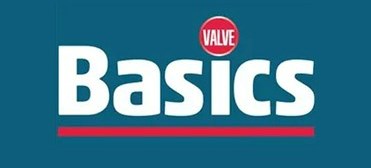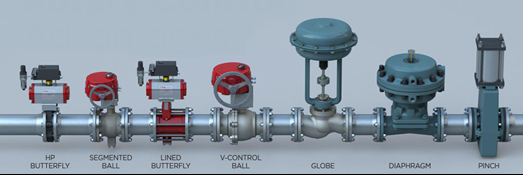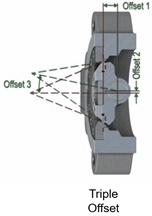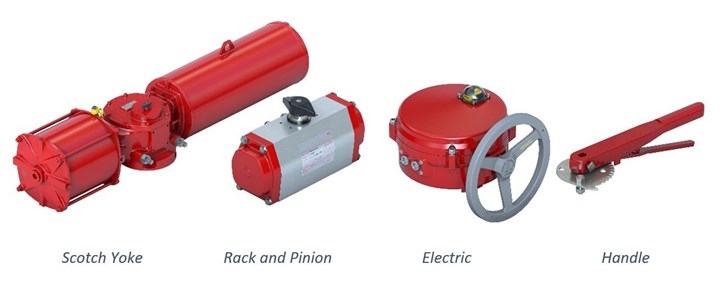
Butterfly valves can be assembled with handles, manual gears, pneumatic or hydraulic actuation. The valve configuration consists of a stem and disc that rotate 90° from open to close in the clockwise direction. Butterfly valves are popular in many applications as they are cost effective to maintain, offer fast operation and are lightweight compared to other types of valves. Most butterfly valves use the same basic configuration, with a body, stem, disc, seat and stem seal; however, other parts may vary between the different butterfly valve types, such as resilient seated, lined, single offset, double offset (often referred to as high performance) and triple offset. These types are differentiated by the geometry of the disc, stem, seat and the material of the seating designs.
A key advantage of selecting a butterfly valve is the reduction of space and weight to a system compared with other options such as ball, check, globe or gate valves. Compared to a gate valve, installation of butterfly valves is less difficult from size and weight, and compared to ball valves, the cost to replace or repair is usually less. Butterfly valves are limited based on their application as they have an obstructed port, as part of the disc always faces the flow even when fully opened and they are not typically utilized in heavy slurry applications as a knife gate or severe service ball valve is preferred. Butterfly valves are also versatile products that can be used in both isolation and light control/throttling services.

RESILIENT SEATED CONCENTRIC
Resilient seated valves are concentric with the pipeline, as the disc is held in the center of the valve. This valve type is position seated, with continuous disc-to-seat interference. Ratings are commonly in cold working pressure (CWP) rather than class rating but fit between ASME Class 125 and Class 150 flanges. Resilient seated valves are often designed below ASME pressure class ratings, thus more cost effective for low pressure applications. Stem sealing consists of a primary seal (seat flat to disc hub), secondary seal (stem diameter larger than a hole in seat) and tertiary seal (upper stem seal).

Typical body materials include ductile iron, cast iron, carbon steel, aluminum, stainless steel and aluminum bronze. Typical seat materials include EPDM, Buna-N, PTFE, natural rubber and more. Resilient seated butterfly valves are mostly used for isolation and control applications including HVAC, chemical and petrochemical, food and beverage, power generation, water and wastewater, oil and gas, mining and dry bulk handling. They are selected based on compatibility with the media running through the pipeline and flow conditions.
POLYMER-LINED CONCENTRIC
Lined butterfly valves are also concentric with the pipeline and designed to be utilized with harsh chemical media: These polymer-lined products offer longer life in media with higher levels of acids. Options include PTFE-lined and PFA-lined valves, both used in the petrochemical, food and beverage industry with corrosive media. One of the main differences between the liners is that in steam engine prototypes PFA liners remain flexible in contrast to PTFE liners over time based on the way they are manufactured. PFA is melted and chemically bonded while PTFE is sintered. Melting and chemically bonding creates a denser material and minimizes air pockets, resulting in flexibility and tight shutoff over long-term use for harsher chemical applications. The PTFE lined butterfly valve is typically used in water, brine, pulp stock and weak acid applications. The disc material can also vary based on application, between stainless steel, or lined stainless steel with PTFE, PFA and UHMWPE (ultra-high molecular weight polyethylene).
HIGH PERFORMANCE
High performance butterfly valves (also called double offset) have two offsets: The first offset of stem is off center to or behind the disc seating face, followed by the second offset, which shifts the stem off centerline of the pipeline. This double offset creates camming action, moving the disc away from the seat rather than across it, reducing rubbing between the disc and seat as seen in concentric and single offset valves.

The double offset is commonly used for isolation and control applications, as well as higher cycle applications when compared to a concentric design. Most applications are made for higher temperature and pressure than resilient-seated valves. The seats are designed to provide reaction force (contact stress) to disc when in the closed position. This contact stress creates the seal with the disc edge. These designs can be pressure dependent, while others use interference fit provided by a seat energizer for that pressure range. Common body materials include carbon steel, stainless steel and aluminum bronze. Common seat materials include PTFE, reinforced PTFE, TFM, UHMWPE and Inconel.
Additional seat designs for specific application can also include fully metal seated and fire safe (both soft and metal seat). The metal seated design can withstand higher temperature capabilities up to 900°F in dirty service, abrasive service and control applications with hot and dirty service. The fire-safe seated design is used in services at risk for fire, using a soft seated material for isolation while still providing a constant metal-to-metal backup seal to the disc in the event of a fire. The intent of the valve design in these applications is to provide isolation to prevent feeding the flames.
The double offset design can be configured for cryogenic applications; they are most often used in industrial gas applications such as argon, helium, hydrogen, nitrogen and oxygen. The choice of materials is based on the service, focusing on toughness and impact strength of the pressure boundary materials at process temperature. The standards for these applications include strict material specifications along with cleaning requirements for safety and operation of the valves while in service.
TRIPLE OFFSET
Triple offset valves share the first and second offset concept with high performance butterfly valves and include an additional third offset, with the seating surfaces using an inclined conical surface. This third offset enables the sealing element (seal ring) to only engage the seating surface in the final

degree of closing (and immediately disengaging from the valve seat upon opening) resulting in no rubbing between the sealing components. This valve type is torque-seated, meaning torque is applied to load the sealing elements and provide the shutoff performance. The seal ring can either be laminated layers of metal and graphite or a solid metal sheet, both of which are field replaceable. The valve seat can either be bolted in (field replaceable) or integral to the valve body. Triple offset valves are inherently fire safe and applicable to pressure classes from Class 150 up to Class 1500. This design can be used in a broad temperature range of -320°F to 1,500°F in varying configurations due to the metal-to-metal sealing.
Common body materials include carbon steel, stainless steel and aluminum bronze while common seat materials include 316 stainless steel hard-faced, nickel aluminum bronze, Stellite and duplex stainless steel. Common seal materials include laminated duplex stainless, Monel, XM-19 or Inconel metal layers with either graphite or PTFE, and solid metal options include duplex stainless steel, Inconel or XM-19. Main applications for the triple offset valves include steam-distribution, petrochemicals, tank farms, terminals, and switching.
The triple offset valve configured for cryogenic service, allow for temperature as low as -420°F; it is used in LNG, liquid hydrogen and liquid oxygen service, to name a few. Extended bonnets keep the stem packing from the extreme cold temperatures.
The higher temperature designs, up to 1,500°F, use a solid seal ring and a bonnet to dissipate heat transfer to the packing and actuation. This design is mostly used in turbines, molten salt and hot air applications.
END CONNECTION TYPES
Butterfly valves have multiple options for end connection types, including wafer (flangeless), lug, double flanged and buttweld end. Some options allow for ease of maintenance, some are suited for dead-end service and some designs have weight and cost reduction implications compared to each other.

- Wafer valves are designed to be installed between flanges, with a short face-to-face dimension in relation to the pipeline diameter. These valves cannot be used for dead-end service, which requires additional isolation valves when shut down for maintenance. Wafer options are lighter and cheaper than lug style and often used in lower pressure applications.
- Lug valves are designed to be bolted to one or both flanges using fasteners threaded into lug protrusions on the valve body, with a short face-to-face dimension in relation to the pipeline diameter. These valves can also be used in dead-end service depending on seat design but may be de-rated and can be heavier than wafer style.
- Double flanged valves are designed with flanges on both ends of the body to secure the valve to mating flanges on the pipe with bolts or studs and nuts. They can be used in dead-end service; however, some valve types may be de-rated.
- Buttweld end valves are designed with bevels (weld preparation) on each face to match thickness and bevel on the pipe. The two ends are butted to the pipeline and welded, used in applications where dismantling is not common, or a potential leak path between flange bolting is a concern.
AUTOMATION TYPES
Many types of actuators can control the opening and closing characteristics of a butterfly valve. The actuator provides the torque required to properly open and close the valve during service. The following types of actuators are paired with butterfly valves:

- Manual valve operation is the simplest form of actuation. It uses a wheel or lever to control the position of the stem and disc. Manual operators are also very inexpensive and typically are used with smaller sized valves that have a lower torque requirement. These are especially suitable in applications where power is not present to operate the valve. The speed of manual operators is somewhat slow, so they would not be used in emergency shut-off applications.
- Electric valve actuators contain a gearbox that can adjust motor speed, raising or lowering the torque. The electric actuators are easy to maintain, are relatively simple to install and are fairly quiet during operation. The position of the valve is based on the voltage or current signal input and can contain limit switches that stop the actuator when fully closed or fully open. Electric actuators are used where there is a stable power supply.
- Rack and pinion actuators contain springs within a chamber that operate from the entry and exit of compressed air. These types of pneumatic actuators can be single or double acting, are compact in design, relatively inexpensive and lightweight. They have quicker reaction times, allowing for their use in throttling services; they need an external supply of compressed air.
- Scotch yoke actuators can be operated with compressed air or with hydraulic fluid. These consist of a crank and piston in a hollow cylinder. Pressure is applied to one side, and the resulting force moves the piston linearly to rotate the stem and disc. These actuators can be designed with modules for ease of maintenance by just removing one section of the actuator instead of the entire assembly. The scotch yoke is larger and more costly than the rack and pinion, but output creates much higher torque for larger sized valves. The scotch yoke also can be paired with control accessories for use in quick acting or soft closing applications.
- Hydraulic valve actuators use hydraulic force supplied by a fluid to control the position of the disc and stem. They are available in either single or double acting. Single acting works by the absence of fluid pressure, keeping the valve in the closed position; as pressure builds up, the fluid pushes the piston towards the valve to open. The double-acting type contains a hydraulic pump that changes the direction of the fluid to open and close the valve. These actuators are used for the very large or heavy-duty valves that require a large torque to operate; they also can be used with solenoids to better control position.
BUTTERFLY VALVE DESIGN STANDARDS
Butterfly valves have many national and international standards that dictate the design criteria, such as wall thickness, face-to-face length, mounting patterns, flange drilling, fugitive emission and more. Below are some of the common standards for the many types of butterfly valve designs.
Common Standards for Valve Design

Butterfly valves offer a unique value proposition based on their weight, footprint, and cost effectiveness. They provide a variety of options from seat material, sealing designs, and range of temperature and pressure ratings. Butterfly valves offer one of the largest valve markets behind ball and gate valves. They continue to grow based on the flexibility of automation, lower torque and improved fugitive emissions performance compared to linear valves.
About the Authors
Haley Ferner holds a technical marketing position for Bray International, previously serving in roles including engineering, certifications and quality assurance with more than seven years of experience. In her current position, she assists industry managers by creating industry-focused collateral and assisting with training presentations. Ferner graduated from Texas A&M University with a Bachelor of Science in Manufacturing and Mechanical Engineering Technology.
Mitchell Anderson, a valve and actuator industry veteran of more than 15 years, serves in engineering, manufacturing and quality assurance roles. Anderson holds a Bachelor of Science degree in Engineering from Texas A&M University. He has been a committee member for development of API, ISO, and ASME standards and is a current member of the VMA Education & Training Committee. Anderson currently is director, Butterfly Valve and Ball Valve Engineering at Bray International in Houston, TX.
RELATED CONTENT
-
The Misunderstood Check Valve
Too often this valve is unjustly blamed when problems occur, but the real culprit is its use in the wrong applications.
-
Ancient Roman Valves
The story of water supply in the ancient Roman Empire is grand.
-
Valve Basics: Electric Actuator Controls
Electric valve actuators control the opening and closing of valves. With a motor drive that provides torque to operate the valve, these actuators are frequently used on multi-turn valves such as gate or globe and also on ball, plug and other quarter-turn valves.









 Unloading large gate valve.jpg;maxWidth=214)

